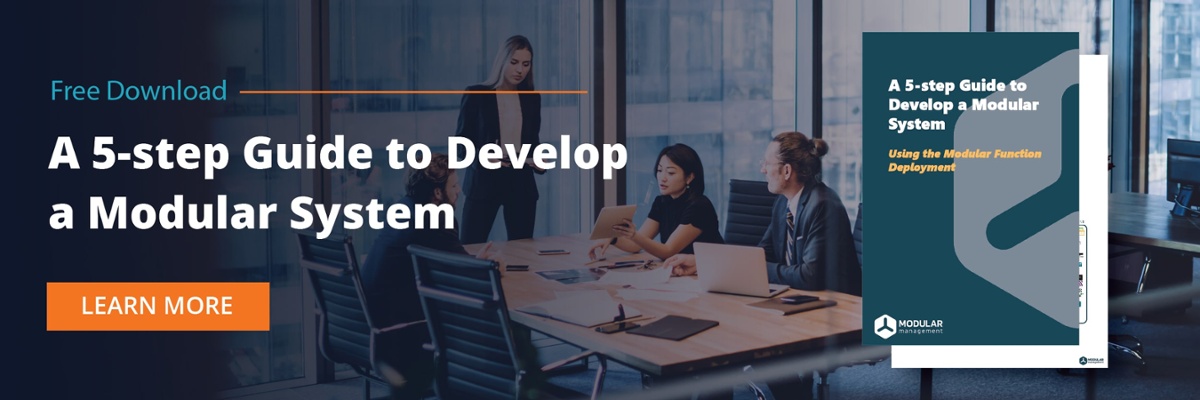What is Modular Product Architecture?
Businesses with complex product offerings, composed of multiple technical systems, offered to different markets through different channels, have a challenge in structuring their product in a way that allows them to get positive scale effects while still enabling flexibility in the offering and speed in the development cycle.
The company’s core functions will have different views of the product and its structure. And rightly so, since this structure is a tool to achieve clarity, re-use, and clarify responsibilities in product ownership.
Let’s start with a few definitions to set the stage for this blog series on lifecycle management of configurable and modular products. I will start with this post suggesting a common vocabulary and providing an overview of the product architecture structure.
The External and Internal Perspectives of a Product
The external view of the product offering is often referred to as a portfolio. This portfolio consists of products or sometimes of families or models. A product or a model (which I would use as synonyms) could either be entirely determined or have options that the customer selects – in turn, defining the fully determined product. A product family is, by definition, a collection of products with some parameters that are not set but probably also many common parameters across the family.
The product portfolio may be split into multiple parts. There could be many drivers for this split, e.g., different portfolios for different regions, channels, or brands. Typically, the split is driven by a separation of responsibilities, where, e.g., brands or regions are managed by different parts of the organization.
The External View: The Product Portfolio
The external view of the product offering is often referred to as a portfolio. This portfolio consists of products or sometimes of families or models. A product or a model (which I would use as synonyms) could either be entirely determined or have options that the customer selects – in turn, defining the fully determined product. A product family is, by definition, a collection of products with some parameters that are not set but probably also many common parameters across the family.
The product portfolio may be split into multiple parts. There could be many drivers for this split, e.g., different portfolios for different regions, channels, or brands. Typically, the split is driven by a separation of responsibilities, where, e.g., brands or regions are managed by different parts of the organization.
The Internal View: The Product Architecture
The internal view of a product offering can sometimes share the same structure as the external view. But, perhaps more often, it has a different structure where multiple models are built on the identical product platform. A product platform is typically cut the same way as a product, i.e., it would include all the needed assemblies to make the product. The product platform would assume some level of modularity, with the option to change the product’s performance in some aspect by only changing some components.
However, there could also be platforms for subsystems that cut through multiple product platforms. These subsystem platforms are sometimes referred to as shared platforms, or transversal platforms (referring to the fact that they are cut the other way than a product). One such example could be an engine platform, used across many vehicle platforms.
Any platform would consist of modules that may appear in one or more variants. If we consider an engine platform for example, the cylinder head could be referred to as a module, with different variants dependent on the engine layout (V6, V8, etc.), valve types, and other attributes.
With the engine as an example of a modular platform, the engine platform itself has the characteristics of a module in the larger scheme of things (across the different product platforms). Summarizing these definitions brings us to an illustration of the product architecture.
How the External View Meets the Internal View
Previously, we defined that the marketed configurable object could be referred to as a product, a product family, or a model. Additionally, a product platform could be used for multiple models. The MEB Platform from Volkswagen Group is one such example. This platform is the base for many models, across various brands such as the Volkswagen ID 3, ID 4, ID 5, Skoda Enyaq, Audi Q4 e-tron, and Cupra Born. The larger the share of the complete portfolio based on the same platform, the larger the scope of the platform. An extreme example of this method is the so-called unified platform, which covers the whole portfolio with a single product platform. Such is the case with the in-development SSP platform from Volkswagen Group.
As mentioned, a product portfolio could be split to divide responsibilities for brands, regions, etc. We can create a complete illustration that joins the external and internal views.
Products, Platforms, Portfolios, Architecture-Words that Need a Common Understanding
As stated at the start of this post, I do not put a heavy weight on words and definitions. However, I do put weight on reaching clarity and alignment within a business. It is crucial that a company can communicate efficiently within and across functions and regions to create an aligned view of what they are striving for. Since it is practically a law of nature that different functions are responsible for the external and internal view of the product – they must meet to align their roadmaps, and to do that, they must share a view of what the product is.
Check back to read the next article in this series on lifecycle management.
Want to Know More?
We are always interested to hear your story and discuss how you can improve from where you are, let us be your sounding board. Contact me directly via email if you'd like to discuss the topic covered or have general questions about modularity. Additionally, feel free to contact us with the use of our contact form.
 AUTHOR
AUTHOR
Tobias Martin
Vice President and Partner at Modular Management
tobias.martin@modularmanagement.com


